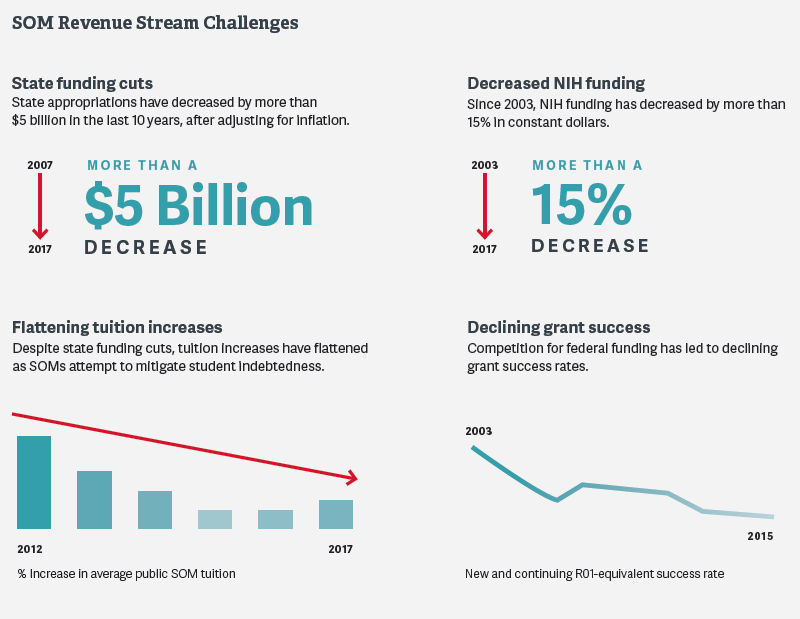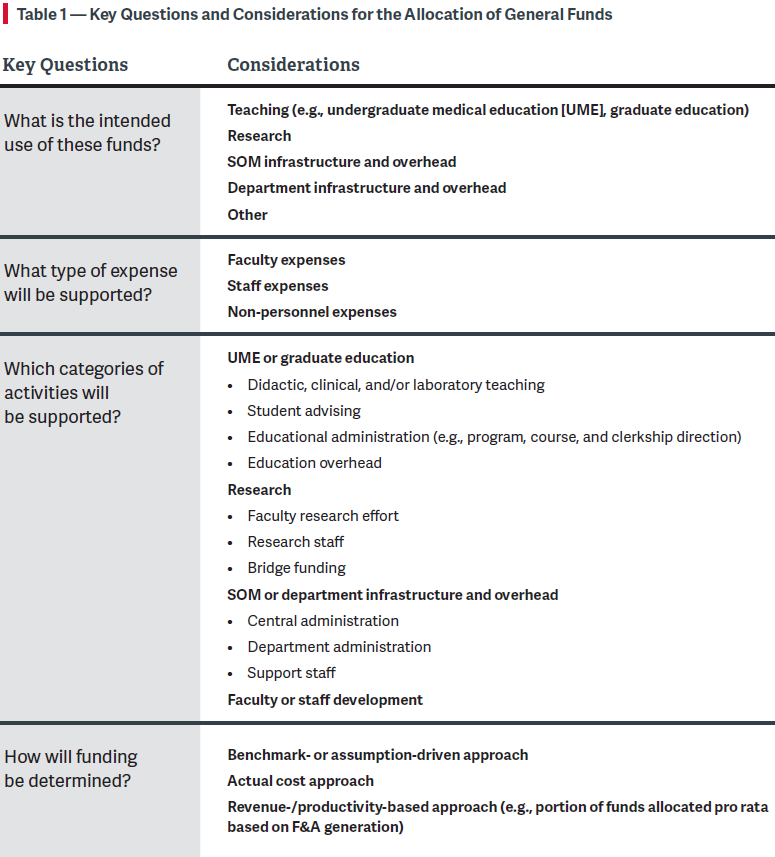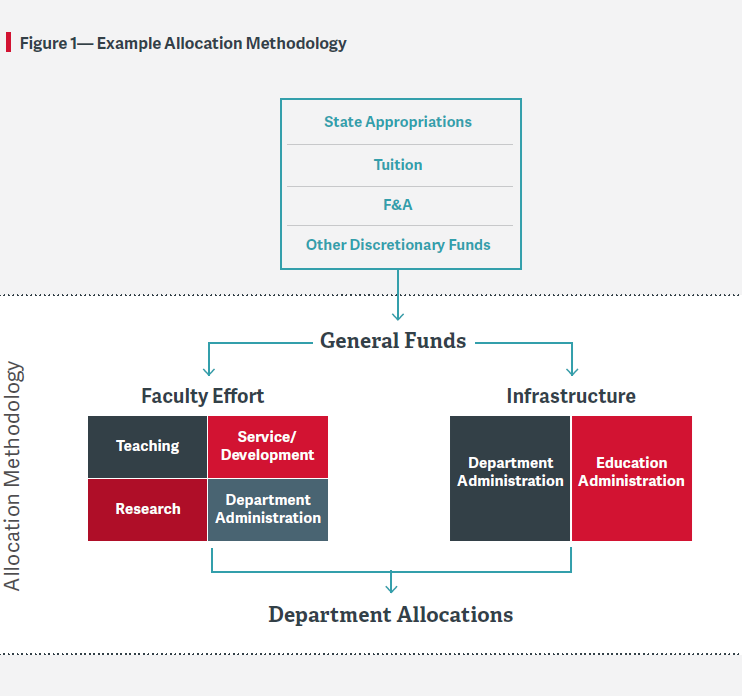
In recent years, schools of medicine (SOMs) have faced increasing revenue stream challenges, including greater competition for a consolidated and flattened pool of grant funding, limited ability to increase tuition, and decreases in state appropriations. In addition, academic health systems are experiencing rising cost structures and uncertainty regarding how they will be reimbursed, ultimately propelling them to reexamine their finances and scrutinize funds flow arrangements with their SOM partners. These challenges have led SOM leadership teams to evaluate the distribution and use of their own limited resources and embrace more disciplined, data-driven approaches to financing academic activities, thus assuring internal and external stakeholders that funding is aligned with mission-critical activities.

As SOMs have examined their existing methodologies for investing general funds1 in departments and programs, several themes have emerged:
- Allocations of funding do not accurately reflect faculty or department effort in core mission areas.
- Distribution methodologies are unclear and often based on historical negotiations.
- Funding is misaligned with institutional priorities and initiatives related to teaching and research.
- There is often no common understanding among SOM and department leadership regarding the intended purpose or optimal use of these funds.
Transitioning from a negotiation-based, subjective allocation methodology to a defined and data-driven approach helps to ensure that resources are used appropriately and aligned with the academic priorities of the SOM.
DEFINING A NEW APPROACH
A revised approach must be based on a set of clearly articulated allocation principles that define the type of activities for which general funds will be distributed. These principles should be enduring and be in alignment with the business objectives of the organization. Once allocation principles are defined, specific methodologies can be developed that objectively distribute funding to departments. The revised approach must reflect the strategic direction of the SOM and be flexible enough to change as the SOM’s priorities shift. Key questions and considerations for defining a revised approach are shown in Table 1.

An approach recently developed by ECG and an SOM client partner is shown in Figure 1. The methodology aligns funding with key SOM priorities in a formulaic approach that equitably recognizes faculty effort and other expenses across all departments. The SOM leadership team considered the questions posed in Table 1 and identified several areas for which to provide institutional support, including faculty effort related to teaching, research, service/development, and department administration. Allocations are also provided for nonfaculty and infrastructure expenses related to department and education administration.

The model values faculty effort and infrastructure expenses using a combination of publicly available benchmarks and internally developed assumptions for specific categories. Funding is then allocated to departments as a block grant for subsequent utilization by the department chair at their discretion to meet the goals, objectives, and expectations of the department and the SOM. Sample approaches for selected categories are described below.
Didactic Teaching
Didactic teaching effort is determined using contact and preparation hours based on curriculum and registrar data. Faculty hours are converted to didactic teaching FTEs, which are then valued using benchmarks from the AAMC Faculty Salary Report.
Clinical Teaching
Clinical teaching effort for required clerkships is determined using an internally developed assumption for contact hours per student per week. Reported student enrollment and clerkship duration (in weeks) are provided by the registrar and utilized to determine total faculty hours. Faculty hours are converted to clinical teaching FTEs, which are then valued using benchmarks from the AAMC Faculty Salary Report.
Service/Development
An internal assumption is utilized, which distributes a fixed dollar amount per faculty FTE. The assumption broadly recognizes faculty effort for internal service commitments and provides allocations for faculty development and continuing education.
Department Administration (Infrastructure)
A standard benchmark-based ratio of administrative support staff per faculty member is utilized across all departments. This ratio is applied to the number of faculty members to identify support staff FTEs by department. Support staff FTEs are then valued using benchmark-based compensation.
SUCCESS FACTORS
In assisting our clients across the country with designing more contemporary resource allocation methodologies, we have identified the following success factors to make this cultural and financial transformation:
Key Stakeholder Engagement
Given the importance of these general funds to departments, it is imperative that appropriate measures are taken throughout the methodology development process to ensure stakeholder buy-in, promote confidential but effective feedback, and address sensitivities to potential changes in support levels. Based on our experience, we recommend that SOM leadership involve key faculty and administrators in the development of a revised approach through a committee or work group structure. We also suggest conducting periodic updates with department leadership and faculty members not directly involved in the development process to foster understanding and endorsement of a revised approach.
Implementation Planning
The revised allocation methodology will result in shifts in the financial resources available to departments, some of which may be significant. We recommend that SOMs utilize a phased implementation approach to mitigate swings in funding for historically over- or underfunded departments. As needed, department-specific business plans should be developed to ensure that the fulfillment of the academic mission is not compromised in departments with reduced funding and that departments receiving additional funds invest them in approved programs and initiatives.
Ongoing Management and Evaluation
The allocation methodology that is developed must be reviewed and updated annually and adjusted to reflect the amount of available general funding. In addition, each year, SOM leadership teams should discuss the key questions posed in Table 1 and reexamine the intended use of funds, the type of expenses and activities supported, and the funding approach utilized. This ensures that the investment of general funds by the SOM aligns with the priorities and financial realities for the fiscal year.
The establishment of a robust and objective resource allocation
methodology for general funds requires minimal investment for an SOM but yields significant benefits.
LOOKING AHEAD
The establishment of a robust and objective resource allocation methodology for general funds requires minimal investment for an SOM but yields significant benefits. A well-defined and formulaic distribution approach will:
- Demonstrate a rationale for and fairness in supporting the academic activities of departments.
- Improve the transparency of and reasoning behind management decisions.
- Enhance accountability for resources provided by the state and/or parent institution.
- Assure clinical partners that funding is data-driven and linked to mission-critical activities.
Redefining the investment strategies of an SOM and aligning key revenue sources with mission-critical activities will ensure that the organization is well-positioned for long-term academic and financial success.
Footnotes
1. General funds commonly include one or more of the following: tuition, state appropriations, facilities and administrative (F&A) funds, and other discretionary dollars.

